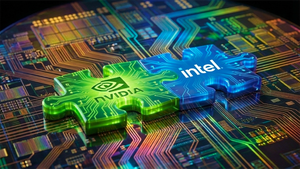
The unprecedented surge in Artificial Intelligence (AI) investments has ignited a fierce debate in financial markets: are companies genuinely reaping material benefits from their massive capital outlays, or is the industry caught in a speculative bubble mirroring the dot-com era? A recent MIT survey paints a sobering picture, suggesting that despite billions poured into generative AI (GenAI) projects, the vast majority of firms are yet to see measurable profit gains. This stark reality check, juxtaposed with OpenAI CEO Sam Altman's cautious optimism about AI's long-term potential amid short-term "bubble" concerns, is forcing a re-evaluation of tech valuations and recalibrating investor expectations across the board.
The GenAI Divide: Billions Invested, Profits Elusive for Most
The current "AI arms race" has seen major US technology companies allocate a staggering proportion of their revenue towards AI-related capital expenditure, approaching 40% in some cases – a five-fold increase since 2020. Projections indicate approximately $350 billion will be spent by just four major tech players in 2025 alone. This monumental investment is driven by the widespread belief in AI's transformative power, yet the materialization of these benefits remains largely unconfirmed for many.
A landmark study from MIT, titled "The GenAI Divide: State of AI in Business 2025," has brought this issue to the forefront. The research, which probed the impact of global investments ranging from $30 billion to $40 billion in GenAI, delivered a striking revelation: a staggering 95% of companies reported no measurable profit gains. This suggests that for nearly all firms, these substantial investments have had little to no discernible impact on their top-line revenue or bottom-line earnings. The study found that much of the current use of popular tools like ChatGPT and Microsoft (NASDAQ: MSFT) Copilot, explored by over 80% of major firms, has been confined to enhancing individual employee productivity, rather than translating into improved overall company profits or P&L performance. Furthermore, many enterprise-grade AI systems were "quietly rejected" after initial trials. The MIT report also advised against focusing the majority of AI budgets (50% of GenAI budgets) on sales and marketing, suggesting that targeting back-office automation often yields a better return on investment (ROI). Interestingly, the small 5% cohort of companies that did manage to extract significant value from AI often focused on addressing specific "pain points" and found more success by acquiring or subscribing to existing AI models rather than attempting to develop their own bespoke solutions.
Adding another layer to this complex narrative is Sam Altman, CEO of OpenAI, who has openly acknowledged the "bubble-like" nature of the current AI industry. He suggests that investors are "overexcited" about the technology, drawing parallels to the dot-com boom and cautioning that while some investors are "likely to get very burnt," the long-term value creation by AI for society will be "tremendous." Altman views these bubbles as potentially "productive" for fostering innovation, even if many ventures ultimately fail. He also underscored the immense financial commitment required for AI infrastructure, hinting at "trillions of dollars" in investment over time for data centers, potentially necessitating new financial instruments. These insights, coming from a key player at the forefront of AI development, underscore the tension between the technology's boundless promise and the immediate, often elusive, financial returns.
The initial market reactions to these insights have been palpable. The MIT survey's findings, highlighting the lack of measurable gains for most, reportedly "spooked AI investors," contributing to notable fluctuations and even drops in the stock prices of major tech companies heavily invested in AI, such as Nvidia (NASDAQ: NVDA), ARM Holdings (NASDAQ: ARM), Oracle (NYSE: ORCL), Advanced Micro Devices (NASDAQ: AMD), and Palantir Technologies (NYSE: PLTR). This signals a clear shift towards a more discerning investment environment, where capital is increasingly expected to gravitate towards AI solutions with clear business cases and demonstrable returns on investment. The exuberance that previously drove up valuations based purely on AI potential is now being tempered by a demand for tangible, material benefits.
The AI Gold Rush: Who Wins and Who Risks Being Left Behind?
The current AI investment landscape is carving a clear divide, creating significant winners among the enablers of AI and posing considerable risks for those unable to translate their substantial outlays into tangible profits. The insights from the MIT survey and the cautionary remarks from OpenAI CEO Sam Altman are reshaping how investors view the sector, demanding more than just promise.
Among the clearest beneficiaries are the companies building the foundational infrastructure for AI – the "picks and shovels" providers of this modern gold rush. Nvidia (NASDAQ: NVDA) stands as an undisputed leader, with its Graphics Processing Units (GPUs) and CUDA platform being indispensable for AI computations. Its data center business continues to report record revenues, reflecting its critical role in powering AI development for tech giants like Microsoft (NASDAQ: MSFT), Alphabet (NASDAQ: GOOGL), Amazon (NASDAQ: AMZN), and Meta Platforms (NASDAQ: META). Despite high valuations, analysts remain largely optimistic about Nvidia's long-term trajectory, bolstered by its transition to the Blackwell architecture and sovereign AI initiatives. Advanced Micro Devices (NASDAQ: AMD) is also emerging as a formidable challenger, with its Instinct MI355 accelerators gaining traction among hyperscale customers seeking alternatives. AMD's strategic partnerships, including one with IBM for quantum-centric supercomputing, position it as a strong long-term play, even amidst intense competition.
Oracle (NYSE: ORCL) is making aggressive strides in AI and cloud infrastructure, committing billions to expand its Oracle Cloud Infrastructure (OCI) globally. OCI has seen significant year-over-year revenue growth, driven by increased consumption, and Oracle's hybrid model enables it to secure AI infrastructure at a competitive pace and cost. The company's involvement in OpenAI's "Stargate" joint venture, a massive AI hub, further solidifies its position. ARM Holdings (NASDAQ: ARM) benefits from its foundational architecture underpinning countless chips, and its strategic pivot towards designing complete AI chips and systems aims to capture a larger share of the burgeoning AI chip market. However, this shift also introduces execution risks and potential conflicts with its extensive client base. Furthermore, the major cloud computing giants like Microsoft (NASDAQ: MSFT) with Azure, Amazon (NASDAQ: AMZN) with AWS, and Alphabet (NASDAQ: GOOGL) with Google Cloud Platform are experiencing massive demand for their infrastructure, making them direct winners from the surge in AI development and deployment.
On the application layer, Palantir Technologies (NYSE: PLTR) exemplifies a company successfully translating AI into significant revenue, particularly in government and commercial sectors. Palantir has reported a substantial revenue increase, directly attributing it to the "astonishing impact" of AI. Its Gotham and Foundry platforms are securing high-value contracts, including a $10 billion, 10-year deal with the U.S. Army, underscoring its pivotal role in defense and intelligence. Beyond direct tech players, related industries like utilities and data center providers are also significant winners due to the immense energy and computational demands of AI.
Conversely, the "losers" in this evolving landscape are likely to be companies with undifferentiated AI offerings, weak business models, or an inability to demonstrate tangible ROI from their AI investments. Altman's warnings about an "AI bubble" suggest that many startups with "insane" valuations and little more than an idea could face severe corrections. The MIT survey's finding that 95% of companies saw no measurable profit gains from generative AI is a stark reminder that simply adopting AI tools like ChatGPT or Copilot for individual productivity doesn't automatically translate into P&L performance. Companies pouring money into AI without a clear, profit-driven strategy risk becoming significant underperformers. Moreover, late adopters and non-innovators, as well as traditional job sectors susceptible to AI-driven automation, could face significant challenges. Even within the semiconductor industry, intense competition means that companies unable to innovate rapidly or secure market share could struggle, and Arm's strategic pivot carries risks that could impact its traditional licensing model if not executed flawlessly.
Industry Transformations and the Echoes of Bubbles Past
The current debate surrounding AI investments is far more than a fleeting market sentiment; it represents a pivotal moment with profound implications for industry structure, competitive dynamics, regulatory landscapes, and global economic power. This intense scrutiny over tangible returns on AI capital expenditure intertwines with the "AI arms race," the daunting "infrastructure cost conundrum," and draws potent parallels to the speculative fervor of the dot-com bubble.
At the heart of this transformation is the escalating "AI arms race," a relentless pursuit of AI supremacy by tech behemoths, agile startups, and even nation-states. This race is fueled by the universally acknowledged potential of AI to redefine sectors ranging from healthcare to finance, promising unprecedented gains in efficiency, decision-making, and novel product creation. Companies like Nvidia (NASDAQ: NVDA) and their indispensable GPUs have become the linchpins of this revolution, powering the cloud infrastructure for nearly all major AI players. Nations, particularly the United States and China, are heavily subsidizing AI research and infrastructure, recognizing its dual role in military advantage and economic dominance. This global competition is driving a digital transformation whose scale and speed are unprecedented, forcing every company, regardless of sector, to fundamentally reassess its strategic position.
However, this ambition comes with a formidable price tag, encapsulated by the "infrastructure cost conundrum." The exponential growth of AI demands equally exponential investments in data centers, high-performance computing, and specialized hardware. Projections indicate that tech giants like Alphabet (NASDAQ: GOOGL), Amazon (NASDAQ: AMZN), Microsoft (NASDAQ: MSFT), and Meta Platforms (NASDAQ: META) are on track to spend over $400 billion on AI infrastructure in 2024 alone, with global AI-related data center expenditures potentially hitting an astounding $5.2 trillion by 2030. This monumental spending strains existing compute, storage, and network capacities, leading to soaring cloud bills, persistent GPU shortages, and escalating data storage costs. The core challenge for businesses is to innovate sustainably, as many struggle to scale their AI initiatives without incurring prohibitive expenses, especially given analyses suggesting that a significant portion of firms currently derive "zero return" from their AI spending.
These dynamics are creating distinct ripple effects across the competitive landscape. Early and effective AI adopters are gaining significant competitive advantages, while slower movers risk obsolescence. The sheer scale of investment is also leading to increased market concentration, with a handful of dominant players, often dubbed the "Magnificent Seven" tech stocks, accounting for a disproportionately large share of market indices. This concentration can stifle broader innovation and create a near-monopolistic environment, making it exceedingly difficult for smaller competitors to gain traction. Furthermore, the reliance of many businesses on core AI models and platforms provided by a few key players like OpenAI and Microsoft creates strategic dependencies, leaving them vulnerable to changes in pricing, access, or developmental roadmaps.
The rapid, often unchecked, advancement of AI is also provoking a growing wave of regulatory and policy concerns. Governments globally are grappling with critical issues like algorithmic bias, misinformation, intellectual property rights, data privacy, and the potential for misuse. Ethical concerns regarding AI's potential to discriminate or compromise data sovereignty are prompting urgent calls for robust regulatory frameworks. The European Union's comprehensive, risk-based AI Act stands as a pioneering example, while other nations, like the UK, favor principles-based approaches. Regulators face the daunting task of developing agile policies that can keep pace with the hyper-evolving technology. National security considerations, particularly in the context of economic dominance, are also driving government intervention and strategic partnerships for AI technology access. The potential for widespread job displacement due to AI automation is another major societal concern, prompting urgent discussions about reskilling initiatives and new social safety nets.
Historically, the current AI boom bears striking resemblances to the dot-com bubble of the late 1990s. Both eras were characterized by a fervent, almost speculative, enthusiasm for nascent, transformative technologies, accompanied by elements of "irrational exuberance." Much like the internet, AI is seen as a revolutionary force capable of reshaping entire industries. Both periods witnessed venture capitalists and speculators pouring money into ventures without always a clear path to profitability, leading to sky-high valuations. The massive infrastructure build-out for AI data centers today mirrors the over-optimistic deployment of fiber optic networks during the dot-com era, which eventually led to widespread bankruptcies when demand didn't materialize immediately. However, crucial differences exist. Today's AI capital expenditure is largely financed by the immense cash flows of profitable mega-corporations, a healthier capital ecosystem compared to the debt- and venture-capital-heavy funding of the dot-com era. Moreover, the pace of innovation in AI hardware is significantly faster, and there is a genuine, enormous demand for AI chips, contrasting with the oversupply of fiber optic networks that preceded demand. While both technologies are revolutionary, AI appears to have more immediate and tangible commercialization prospects, with a growing focus on delivering real-world value.
This context has fundamentally shifted investor expectations. The initial speculative enthusiasm is giving way to a more discerning approach, demanding tangible value and demonstrable profitability. Investors are scrutinizing whether AI investments are translating into measurable revenue and profit growth. The MIT study's revelation that most generative AI projects yield negligible returns has prompted a significant recalibration. The focus is shifting from simply investing in "AI companies" to investing in companies that can strategically leverage AI to enhance competitive advantage and deliver clear economic impact. While institutional investors largely still believe in AI's "seismic shift," there's a growing wariness of overvaluation and a need for nuanced analysis beyond binary hype-or-bubble thinking. This includes acknowledging that while AI's long-term potential is immense, market corrections are a distinct possibility in the short to medium term. The high concentration of market value in a few AI-driven tech stocks is also causing unease, leading to advice for greater diversification and rigorous due diligence on companies' commitment to responsible AI and clear ROI frameworks.
What Comes Next: Navigating the AI Frontier Between Promise and Profit
The road ahead for AI investment is a complex terrain, characterized by a dynamic interplay of fervent optimism about its transformative potential and a growing skepticism regarding immediate financial returns. This tension demands strategic pivots from companies, creates new market opportunities and challenges, and points to a future where measurable value will be paramount.
In the short term, the widespread adoption of AI is undeniable, with an impressive jump in corporate integration from 55% in 2023 to 72% in 2024. The immediate benefits are largely centered on efficiency, cost reduction, and productivity gains. AI is automating routine processes across healthcare, finance, and transportation, streamlining data analysis for quicker, more informed decisions, and enabling generative AI to revolutionize content, design, and code creation. Enhanced customer service through AI chatbots also presents an immediate, tangible improvement. However, the MIT survey's finding that 95% of companies integrating generative AI have yet to see a measurable impact on profits highlights a significant short-term hurdle: bridging the gap between individual productivity boosts and company-wide P&L performance. This "bubble of expectations" necessitates a more discerning investment environment, directing capital towards AI solutions with clear business cases and demonstrable ROI.
Looking further ahead, the long-term possibilities of AI are nothing short of revolutionary. Projections from McKinsey suggest AI could add $4.4 trillion in productivity growth from corporate use cases alone and contribute a staggering $15.7 trillion to global GDP by 2030. This monumental impact is expected to drive significant productivity gains, offsetting demographic shifts and leading to a materially higher level of aggregate earnings growth across industries. AI-driven research promises groundbreaking discoveries in medicine, space exploration, and climate science, while also creating entirely new economic sectors focused on AI ethics, specialized consulting, and niche applications. AI is poised to fundamentally reshape how we live and work, transforming everything from global supply chains and marketing strategies to healthcare delivery and the development of smart cities. However, the full realization of this potential is likely several years away, with companies needing to weather interim challenges.
To thrive in this evolving landscape, companies must undertake significant strategic pivots. The most critical adaptation is to shift from viewing AI as a collection of isolated tools to recognizing it as a core "business imperative" that transforms entire functions. This means redesigning workflows with AI at the center, moving beyond merely "plugging in" AI to existing systems. Investment in upskilling and workforce adaptation is crucial, as AI will both displace and create jobs, demanding a prepared talent pool. Robust technology infrastructure, accelerated data productization, and reliable cloud services are essential to handle AI's immense demands. Furthermore, establishing clear governance and ethical frameworks is paramount to manage risks, ensure transparency, and build trust in AI deployments. In a world increasingly dominated by AI search engines, businesses must also adapt their marketing strategies from traditional SEO to AI-focused approaches like Generative Engine Optimization (GEO) and Answer Engine Optimization (AEO) to maintain visibility.
Emerging markets (EMs) present a unique set of opportunities and challenges. AI offers EMs the chance to leapfrog traditional development stages, accelerating economic and social progress, particularly where legacy infrastructure is limited. AI applications can provide innovative solutions to local challenges in sectors like agriculture and financial inclusion, with localized models trained on regional data proving vital. However, EMs face significant hurdles, including infrastructural deficiencies, skill gaps, regulatory uncertainty, and cultural resistance. Language barriers, stemming from AI models primarily trained on Western English data, also create a "second-language disadvantage." Overcoming these will require investment in telecommunications infrastructure, education, regional data-sharing policies, and localized ethical frameworks.
Given the current sentiment, several scenarios could unfold. An optimistic scenario envisions AI driving unprecedented global economic growth, solving complex challenges, and significantly improving quality of life, as widespread adoption translates into tangible benefits across diverse industries. Conversely, a pessimistic outcome could see a significant market correction if investor confidence erodes due to a persistent lack of demonstrable ROI for most companies, potentially triggering an "AI winter" characterized by declining funding and interest. The most probable outcome is a balanced scenario: a maturing market with ongoing consolidation. Larger, more established players will likely acquire innovative AI startups, and companies will need to continually adapt, prioritizing responsible AI development and thoughtful regulation to mitigate risks while harnessing benefits. Investment decisions will increasingly be grounded in robust, forward-looking insights, with a strong focus on strategic programs that demonstrate actual profit impact.
Conclusion: The Dawn of Discerning AI Investment
The debate over the material benefits of AI investments marks a crucial inflection point in the technological and financial landscape. What began as a wave of speculative enthusiasm, propelled by the undeniable transformative power of Artificial Intelligence, is now maturing into an era demanding tangible, measurable returns. The stark findings from the MIT survey, revealing that 95% of companies investing in generative AI have yet to see measurable profit gains, serve as a potent reality check. Coupled with the cautionary insights from OpenAI CEO Sam Altman, who openly acknowledges the "bubble-like" nature of the current AI market, investors and businesses alike are being forced to recalibrate their expectations and strategies.
Moving forward, the market will increasingly distinguish between companies merely embracing AI rhetoric and those genuinely integrating it to drive demonstrable value. The "picks and shovels" providers of the AI revolution—semiconductor giants like Nvidia (NASDAQ: NVDA) and Advanced Micro Devices (NASDAQ: AMD), cloud infrastructure providers such as Microsoft (NASDAQ: MSFT), Amazon (NASDAQ: AMZN), and Alphabet (NASDAQ: GOOGL), and strategic platform companies like Oracle (NYSE: ORCL) and Palantir Technologies (NYSE: PLTR)—are well-positioned to continue their growth as the foundational enablers. However, companies investing without a clear, profit-oriented strategy, or those with undifferentiated AI offerings, face significant headwinds and the risk of becoming "losers" in the long run. The parallels to the dot-com bubble are compelling, yet crucial differences, particularly the funding sources from profitable mega-corporations and the immediate, immense demand for AI hardware, suggest a more fundamentally sound, albeit still volatile, landscape.
The lasting impact of this period will be a shift towards a more disciplined approach to AI adoption. Future success will hinge on strategic integration, where AI is not just a tool but a core business imperative that redesigns workflows and creates new value streams. Companies must prioritize upskilling their workforces, ensuring robust data and infrastructure readiness, and establishing strong ethical and governance frameworks. The immense capital pouring into AI infrastructure, while vital, also underscores the "cost conundrum" that requires careful management to ensure financial sustainability.
Investors in the coming months should closely watch for companies that demonstrate clear, measurable ROI from their AI initiatives, moving beyond mere productivity enhancements to actual profit gains. Scrutiny of capital expenditure versus tangible returns will intensify. Diversification within the AI sector, a focus on companies with strong underlying business models, and a keen eye on regulatory developments—especially around data privacy and ethical AI—will be crucial. The AI revolution is far from over; it is simply entering a more discerning and accountable phase, where the true winners will be those who can translate transformative potential into material, sustainable benefits.





